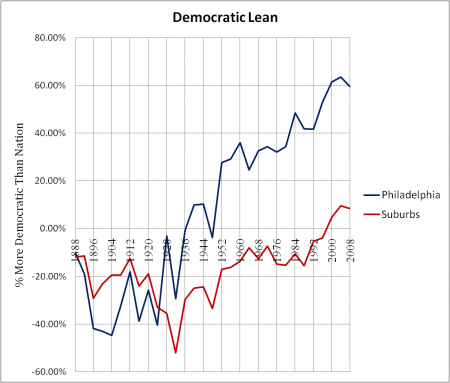I tried out the new partisan data feature for Maryland in Dave’s App. I made an 8-0 Democratic Gerrymander. Just for kicks, I also made a 4-4 GOP Gerrymander, although there is no chance that the Republicans will control redistricting in Maryland. The Democratic gerrymander shamelessly aims to make every seat about as Democratic as the state of Maryland as a whole, while the GOP gerrymander aims to squeeze out the maximum number of lean-Republican districts, although it is not certain that Democratic incumbents would be defeated in all 4 seats.
8-0 Democratic Gerrymander
4-4 Republican Gerrymander
8-0 Democratic Gerrymander
MD-1 60-37 Obama
MD-1 contains all of the Eastern Shore except Cecil County (which you can argue is not really part of the “Eastern Shore” of Maryland). Then it jumps across the Chesapeake to Annapolis, and goes spiraling inland to pick up Democratic precincts in the DC suburbs. Kratovil should now be more worried about a primary challenge than the general election.
MD-2 59-38 Obama
I maintained the overall design of MD-2 and MD-3, giving each part of the Baltimore suburbs. MD-2 picks up Cecil County from MD-1. Ruppersburger remains just as safe.
MD-3 59-38 Obama
MD-3 combines part of Baltimore City and County with parts of Anne Arundel and Howard Counties. No real change for John Sarbanes.
MD-4 71-26 Obama; 50% Black
I tried to get the most I possibly could out of MD-4… The district is based in Prince George’s County, but now stretches through a very thin strip of land all the way to Garrett County in the far western corner of Maryland. Despite my best efforts and this district’s preposterous shape, I could not find a way to get it below 71% for Obama without bringing the African American percentage under 50%. Donna Edwards has nothing to worry about.
MD-5 62-36 Obama
MD-5 becomes a little less Democratic, mostly to help MD-1. But the overall shape of the district remains, and Hoyer is safe.
MD-6 59-39 Obama
Wave goodbye to Roscoe Bartlett (R). Most of his district is now in Montgomery County. A Democrat from Gaithersburg/Rockville should have little difficulty dispatching him.
MD-7 62-35 Obama; 50% Black
Although MD-7 is 50% Black, it only voted 62% for Obama. The white voters in the Baltimore Suburbs and Harford County are strongly Republican. Elijah Cummings ought to be fine, but he would be wise to make at least some effort to appeal to some white voters.
MD-8 60-37 Obama
Strongly Democratic Montgomery County dilutes GOP leaning areas of Howard, Baltimore, and Carroll Counties. Chris Van Hollen should be quite safe.
4-4 Republican Gerrymander
MD-1 56-41 McCain
This version of MD-1 is actually a bit more Democratic than the current version. But Frank Kratovil is unlikely to ever be truly safe in a 56-41 McCain district.
MD-2 52-45 McCain
It is possible that either Dutch Ruppersberger or Paul Sarbanes could win in this Baltimore Suburbs district, but MD-2 now leans GOP.
MD-3 77-21 Obama
MD-3 is a Central Maryland leftovers district, stretching from the DC suburbs to the Baltimore suburbs, taking the most Democratic areas that remain. This is essentially an open seat. Neither Paul Sarbanes or Steny Hoyer live in this district, though might potentially prefer running in MD-3 than the alternative of running in a GOP leaning district.
MD-4 89-9 Obama; 69% Black
This version of MD-4 packs Democratic and African American voters in Prince George’s County to just about the maximum possible extent. Donna Edwards is very safe, but what a waste of Democratic votes.
MD-5 51-46 McCain
All the most Democratic areas are taken out of MD-5, as it moves out of Prince George’s and further north in Anne Arundel County. Steny Hoyer could probably still win this version of MD-5, but he would have to campaign for it, and he would face continual challenges.
MD-6 55-42 McCain
MD-6 becomes less Republican as it gives up its areas around Baltimore to the 2nd District. Roscoe Bartlett would continue to win in this district, and when he retires another Republican would be favored over any Democrat.
MD-7 87-11 Obama; 64% Black
MD-7 packs Democratic votes very compactly in Baltimore. There are a lot of wasted Democratic votes in this district.
MD-8 71-26 Obama
MD-8 actually becomes a little bit less Democratic, but it fulfills its task of keeping the most Democratic areas of Montgomery County out of MD-6.
After having completed this exercise, what strikes me is that the GOP Gerrymander ends up being substantially more compact than the Democratic Gerrymander. While it could be a bit more compact in a few places, it is pretty close to what you would draw if you were basing a map solely on geography. This is a good illustration of the fact that Democratic voters are much more naturally concentrated than GOP areas. In areas where Democrats do the best, everyone is a Democrat (chiefly PGC & Baltimore City). While in the GOP’s best areas, a decent number of people have the sense to be vote Democratic. So overly compact districts tend to result in a few 80/20 Democratic seats and a bunch of 55/45 Republican seats.




